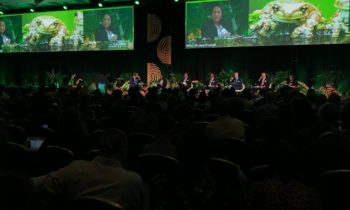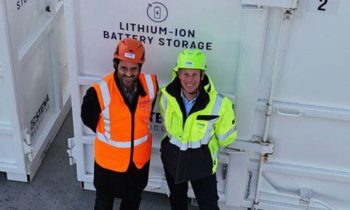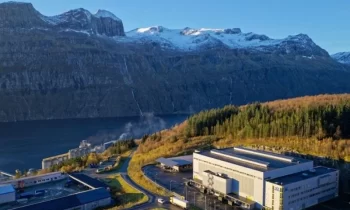 A “golden age” of technology–from satellites and remote sensing to cloud computing, drones and innovative ground data collection–have enabled the tracking and monitoring of the world’s tropical forests, providing an unprecedented opportunity to maximize the role forests play is soaking up and storing carbon and providing many goods and services for sustainable development, reveals a working paper released today at a major global gathering focused on efforts to save the world’s rainforests.
A “golden age” of technology–from satellites and remote sensing to cloud computing, drones and innovative ground data collection–have enabled the tracking and monitoring of the world’s tropical forests, providing an unprecedented opportunity to maximize the role forests play is soaking up and storing carbon and providing many goods and services for sustainable development, reveals a working paper released today at a major global gathering focused on efforts to save the world’s rainforests.
“If we have hope of protecting the world’s forests, everyone involved–from policymakers and law enforcement to investors and indigenous peoples–must embrace the full power of the information age,” said Rachael Petersen, Deputy Director of Global Forest Watch. “Though forests have been here for millennia, only in the last 10 years, thanks to these new tools and data sources, have we gained a detailed understanding of how forest cover is changing worldwide.”
The working paper “Tropical Forest Monitoring,” by a team of researchers from World Resources Institute and Wageningen University, is one of nine studies released today at the opening of the two-day Oslo Tropical Forest Forum, an event hosted by the Norwegian government to celebrate results and identify remaining challenges 10 years after reducing emissions from deforestation and forest degradation (REDD+) was included in the climate change negotiations, and to advance strategies for mobilizing forests to help achieve the ambitions of the Paris Agreement and the Sustainable Development Goals.
“We’re losing forests across the tropics too quickly, mostly due the production of beef, palm oil, soy and wood products–not to mention forest fires,” said Crystal Davis, Director of Global Forest Watch. “But now, we have an arsenal of cutting-edge technologies that help identify where and when forests are being destroyed. Illegal loggers chopping down protected trees, agriculture companies breaking zero-deforestation commitments, palm oil producers setting fire to peatlands and other players behind forest destruction can no longer hide.”
Advances in satellite-based remote sensing and other technologies that have emerged in recent years provide speedy, low-cost methods to map and monitor forests. The researchers point to several key technical improvements: satellite data has become more detailed, enabling the tracking of more subtle changes–such as the sudden appearance of roads or farm plots in protected forests. Some of the satellites can even “see” through cloud cover, smoke and haze, enabling forest monitoring in the midst of forest fires or other weather events. Cheaper computing costs and innovations in artificial intelligence mean researchers can process satellite imagery over large areas automatically using advanced algorithms — including to estimate forest loss for the entire world.
 “In the past, countries compiled statistics on forests from expensive and time-consuming field missions,” said Petersen. “While it’s still important to have ‘boots on the ground,’ in the battle to save forests, we increasingly rely on ‘eyes in the sky’ to give us a comprehensive picture of where forests are located and how they are changing.”
“In the past, countries compiled statistics on forests from expensive and time-consuming field missions,” said Petersen. “While it’s still important to have ‘boots on the ground,’ in the battle to save forests, we increasingly rely on ‘eyes in the sky’ to give us a comprehensive picture of where forests are located and how they are changing.”
For example, it is often too dangerous or expensive to track illegal activity on the ground. These new technologies are helping governments and NGOs crack down on forest crimes, sometimes for the first time. Satellite images, when combined with additional data like national park boundaries or logging permits, are especially useful in providing “early warnings” of ongoing illegal activity, such as the building of a road, enabling law enforcement to swoop in investigate before activity spreads.
-
In 2004, Brazil developed the first national early warning system, called DETER, to target illegal logging and the illegal clearing of land for agriculture. The national environmental enforcement agency (IBAMA) uses DETER to determine which field investigations they should undertake and how best to implement national laws and policies. Peru and Colombia are developing similar systems for cracking down on illegal deforestation.
-
The Peruvian Ministry of Environment (MINAM) distributes weekly forest disturbance alerts via their online portal Geobosques to over 800 subscribers from government, civil society and the private sector. The alerts help Peruvian authorities to identify, halt, and prosecute cases of illegal logging and mining.
-
In Uganda, the Jane Goodall Institute trained monitors at Uganda’s National Forest Authority (NFA) and park rangers with Uganda Wildlife Authority (UWA) to use weekly forest disturbance alerts to monitor national parks and forests. NFA and UWA staff now use those alerts and other data to prioritize patrols, find and document illegal forest clearing. These data have led to prosecutions, fines, and investigations within several critical habitats, including Kibale National Park.
Satellite data, the paper says, is also critical for consistently measuring progress on the protection of forests and quantifying how much carbon is stored in trees, a prerequisite for programs like REDD+ that reward forest nations for keeping trees standing. These forest monitoring technologies also offer a cheap, consistent, and reliable way to track progress on commitments by governments and companies to protect forests.
-
To meet Paris Agreement goals, for example, countries must “inventory” their greenhouse gas emissions, which would require the calculation of forest loss (which emits carbon) and forest gain (which absorbs carbon).
-
Measuring the success of such pledges as the New York Declaration on forests, which aims to halve deforestation by 2020, end it completely by 2030, and restore hundreds of millions of acres of degraded land together with the Bonn Challenge) necessitates the close monitoring of forest re-growth.
-
To be eligible for REDD+ payments, countries must devise national forest monitoring systems to track progress in reducing deforestation and forest degradation against an agreed baseline.
-
Finally, the more than 400 companies that have made pledges to get deforestation out of their commodity supply chains can’t be held accountable for implementing their commitments without accurate forest data.
Thanks to REDD+ readiness funding, many countries have improved their ability to monitor their forests, how much carbon they store, and how they are changing. However, the paper suggests that despite this skyrocketing demand for better forest data, there is a gap between what new technologies make possible and what is still practiced by national officials monitoring forests. Despite significant investments by international donors, tropical forest government agencies often do not have the staff, financial resources, or computing infrastructure to take advantage of rapidly advancing technology.
“Forest nations are increasingly attuned to the importance of saving tropical forests, which not only store carbon, but also provide clean air, fresh water, food, medicines, incomes, and a wealth of plant and animal life,” said Martin Herold, professor of Geo-Information Science and Remote Sensing at Wageningen University. “In the hands of the officials who need them most, these forest monitoring tools could make or break the global fight to save our forests. We should focus our efforts not just on improving the technology, but more importantly, on supporting government institutions to adopt it and apply it to their biggest challenges moving forward.”
“We will soon be able to detect deforestation every day in high resolution from space. But it won’t do any good if the knowledge stays in research labs or academic publications. Park rangers, law enforcement officers, and indigenous peoples need to act on this information. While technology continues to improve, we should invest greater resources on building the capacity to own this information and incentives to support data-based decision making,” Petersen added.
At the same time, forest monitoring efforts carried out by non-government organizations and posted online, can help citizens access forest data when national governments don’t share their numbers. Indigenous people, for example, seeking to claim rights to their forests to protect them from destruction, increasingly complement their forest monitoring efforts at the local level–using drones, GPS and mobile phones–with satellite data.
The paper cautions, however, that that the rapidly expanding options for monitoring forests poses a new set of challenges. As forest-measuring tools proliferate, varying factors, such as the definition of a forest, the time frame measured or the quality of the data, can lead to conflicting estimates of the deforestation rates, and a lack of comparability across countries. The authors call for a more systematic understanding of how and why country-reported data differ from independent estimates, and suggest that greater guidance is needed for countries to take advantage of recent technological developments and minimize confusion.
“Forest monitoring technology alone won’t save forests,” said Frances Seymour, Program Chair of the Oslo Tropical Forests Forum and lead author of Why Forests? Why Now? “But increased transparency is a critical enabling tool for many of the most promising strategies for stopping deforestation, including enhanced law enforcement, REDD+ financial incentives, and efforts to get deforestation out of commodity supply chains.”



